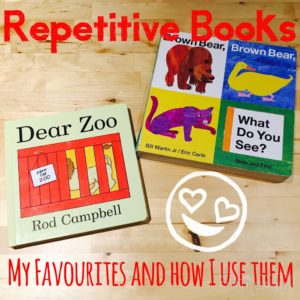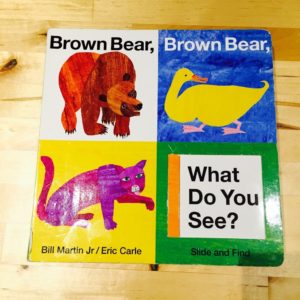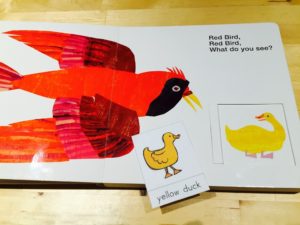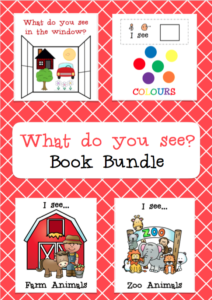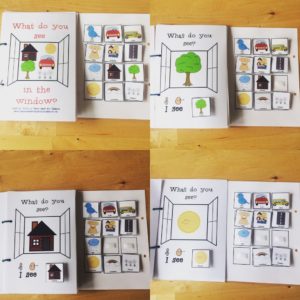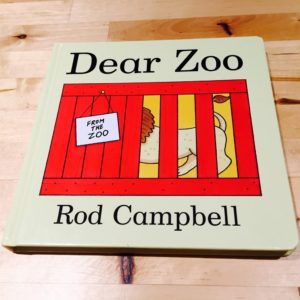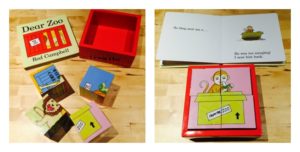I LOVE using books in my therapy sessions with kids of any age. Research suggests that reading to babies as young as 8 months of age can have a significant impact on early language development. In fact there is a ton of research (too many to list!) that indicate that reading to your child will have a positive impact on their expressive (oral) language development and later their literacy skills. One MRI study showed that children between the ages of 3 and 5 whose parents read to them on a regular basis had greater activation in areas of the brain that help with narrative comprehension and visual imagery, both key in the development of language and literacy.
Selecting the right book to read to your child, depends on their age, interests, and stage of language development. If you are the parent of a pre-schooler, you're going to want to avoid:
- lengthy and complicated story books especially books with no or few illustrations.
- E-books! In a study comparing an e-book with the same story in a paper book version, researchers found that children learned more from the paper book.
Factors such as repetitiveness, rhyme, colourful pictures, simple story structure, and interactiveness are positive factors to look for in books when you are reading to young children.
Today I'm going to share with you two of my absolute favourite repetitive books for young preschoolers and language delayed children.
How do repetitive books foster language development?
Repetitive books provide predictable and rhythmic language, both important factors in capturing your child's attention and helping them to remember important words and phrases. The predictable nature of repetitive books allows the child to grasp the content of the story with greater ease thereby decreasing the cognitive load. When the child has less to think about, there are more cognitive resources left for them to use language. Other benefits of repetitive books are:
- new vocabulary words are heard many times throughout the book
- as the child becomes familiar with the book, you can give them them the chance to 'fill in the blanks' of the repeated sentence
- certain language structures such as pronouns or prepositions may be used repeatedly throughout the book
- provides frequent practice of target speech sounds, if your child is having speech sound difficulties
Brown Bear, Brown Bear
By Bill Martin Jr, Illustrations by Eric Carle
Why I love it:
- Sliding Doors: I own the board book version of Brown Bear, Brown Bear which contains little sliding doors that your child can open to reveal what each animal sees. In my opinion, these doors make the book a thousand times better than the paper book version of the story which doesn't have flaps or doors. The sliding doors keep children engaged and I've noticed that children on the autistic spectrum particularly love them. They are nicer than paper flaps because they are super durable and can never be ripped out of the book. The doors give children a way to take a 'turn' in the story telling, they provide a 'surprise,' and allow for practice with prediction (have the child guess what will be behind the door!) and waiting (I always try and get their little hands to wait until I finish reading the question 'what do you see?' before I let them open the door). You can also use it as an opportunity to practice the word 'open.' As I write this, it occurs to me that my love of these sliding doors is so great that it could inspire an entire blog post!
- Provides exposure to colour and animal vocabulary: The only vocabulary words that change on each page are the colour and the animal words thereby putting extra emphasis on them. Your child will learn that those new words refer to the picture on the page and voila! They are that much closer to learning new animal vocabulary and colour vocabulary Read the book multiple times and use the same vocabulary words from the book in everyday situations. After each page, you might point out another red object in the room. When I was an SLP student I found great Brown Bear, Brown Bear animal cards which I laminated and cut out (see 'Related Activities' for the link). After one of my clients has been exposed to the book a few times, I'll have them match the cards to each page. You can also have colour cards, or coloured objects which the child can match to each page of the book.
- Provides exposure to 'I,' 'Me,' and 'You' pronouns: By the age of 36 months, children with typical language development will learn to use the pronouns, 'I' 'Me' and 'You' meaning that you will start to hear less of 'me hungry' and more of 'I hungry.' I love the fact that Brown Bear, Brown Bear, provides repeated exposure to all three pronouns. The more a child hear correct language structures, the more likely they will learn to use those language structures! I often use the book in therapy with children who are not yet using the 'I' pronoun.
- Provides exposure to 'Wh' questions!: The book models repetitive question asking and answering. Children with language difficulties often have difficulties answering questions and answering questions. Because the same question is asked repeatedly throughout the book, the cognitive load associated with asking/answering the question is much lower than having the child ask/answer a novel question. This book provides excellent practice and multiple opportunities to practice these skills.
- Lots of opportunities to fill in the blank: As your child becomes familiar with the book, you can allow them to fill in the blanks. Depending on their language level, you may want to start with getting them to fill in 'me' at the end of 'I see a ___ looking at me!' or you can get them to fill in the animal, or the colour and the animal! For children who are already combining words, this is a great book for increasing utterance length. You can have your child produce the phrase 'I see a ____' or even the entire phrase 'I see a ___ looking at me!' because the only changing words are the colours and the animals. As a result, your child is going to have multiple opportunities to practice a multi-word utterance while only having to think of one or two new words. If your child is non-verbal but using PECS or an AAC device, the same rules apply. Model using the vocabulary with PECS symbols/AAC as you read the story and then have your child fill in the blanks using this method.
Related Activities
After reading a book, I like to extend the vocabulary from the book to other games or activities in order to give a different type of exposure to the same vocabulary words, thereby helping to consolidate the concepts. I found a great FREE Brown Bear Brown Bear resource on a website called 1+1+1+1. There are a ton of resources in this pack, which you can use with children of various language levels and target many different skills such as following directions and matching. The materials that I laminated and use a lot are the animal cards, and the two piece puzzles but there are other great resources in this pack as well.
With children who prefer real objects rather than 2D visuals, I try and gather toy versions of the animals in the book (teddy bears, wind-up frogs, rubber ducks etc). I like to hide each one by putting them in a box, or under a blanket. I then say the lines of the story again but this time the child gets to pull the animal out of the box and say what they see! This gives them the opportunity to practice using the vocabulary from the book but with real objects, helping to give more meaning the each animal word.
If you are working on developing your child's use of 'I see' phrases, you can also download my series of 'I see' interactive books. There are four books available individually or in a bundle:
- I See Colours: colour vocabulary
- I see Farm Animals: Farm Vocabulary
- I see Zoo Animals: Zoo Animal Vocabulary
- What do you see in the window?: Everyday vocabulary words for things children might see out their window!
Dear Zoo
By Rod Campbell
Why I love it:
- It exposes your child to a VERY simple storyline with a beginning, middle and end: The book is very repetitive but unlike Brown Bear, Brown Bear, it is a little more sophisticated in that there is kind of, sort of, a plot. A child writes to the zoo to send him/her a pet (beginning of story), the zoo send him/her many different animals but there's always something wrong with them (middle of story), then the zoo finally sends the perfect animal (spoiler alert: it's a puppy!) and the boy/girl keeps it (end of story)!
- Provides exposure to zoo animal vocabulary: Whereas Brown Bear, Brown Bear is great for exposing your child to more common animals such as 'duck' and 'frog,' Dear Zoo introduces less common animals such as 'giraffe' and 'kangaroo.'
- Provides exposure to descriptive vocabulary: This is actually one of my favourite things about Dear Zoo. It's a great book for exposing children to descriptive words/adjectives. This class of words is often less developed in children's vocabularies especially those with language delays but are just as important as nouns and verbs. Words such as 'tall,' 'grumpy,' and 'fierce' are used to describe the animals. Depending on the age of your child, you can use this book as an opportunity to explain the meanings of these words. After reading the book, you can make an effort to use some of the same terms in your every day life (e.g. 'Daddy is tall.' That is a big ball).
- Provides exposure to pronouns 'I' and 'he' and 'him': Children with typical language development will start to use the pronouns 'he' and 'she' between 31 and 34 months, and the pronouns 'him' and 'her' by around 41 to 46 months. Dear Zoo provides lots of repetitive exposure to the 'he' and 'him' pronouns so it's a great tool for these targets. When I was an SLP student, our professor showed us the great trick of making little bows out of the sticky part of a post-it and sticking them on each animal in order to practice the the female pronouns as well! I love this idea and use it whenever I am working on pronouns (Thanks for the idea Luanne!).
- Lots of opportunities to fill in the blank: Just like Brown Bear, Brown Bear, the repetitive nature of the book allows your child the opportunity to fill in the blank. The phrase 'they sent me a ___' gives your child the opportunity to fill in the animal. It can also be used to practice longer utterances, such as the phrase 'I sent him back.' Again, the child does not have to orally fill in the blank. PECS, AAC, or signing can be used!
- Flaps!: For all of the reasons that I love the sliding doors in Brown Bear, Brown Bear, I also love the flaps in Dear Zoo. The only downfall in Dear Zoo is that although the pages are made of board, the flaps are paper and therefore aren't as durable. All of mine are still in tact though!
Related Activities
Similar to Brown Bear, Brown Bear, I like to reenact the story using real objects. I put toy zoo animals in small gift boxes and then we say the lines of the story, opening each box as we go and labelling the animal and the adjective! A great way to practice the vocabulary that you are targeting whether it be animal vocabulary, describing vocabulary, or pronouns.
I recently found a cute Dear Zoo themed 4 piece block puzzle. I've been using it a lot with the little kiddos on my caseload. You can use it practice following directions ('Make a lion'), or to just give more practice with the vocabulary/phrases from the book.
Thanks for stopping by!
I hope that you found this post informative whether you are a parent looking for tips on how to read to your children or an SLP looking for new ideas about how to target language goals using books. I'd love to hear from you about your favourite repetitive books! I'm always looking for suggestions to grow my book collection 🙂

